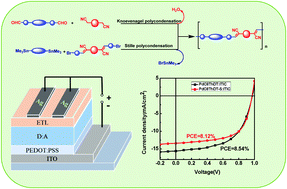当前位置:
X-MOL 学术
›
J. Mater. Chem. C
›
论文详情
Our official English website, www.x-mol.net, welcomes your
feedback! (Note: you will need to create a separate account there.)
Cyanovinylene-based copolymers synthesized by tin-free Knoevenagel polycondensation for high efficiency polymer solar cells†
Journal of Materials Chemistry C ( IF 5.7 ) Pub Date : 2018-07-05 00:00:00 , DOI: 10.1039/c8tc02021c Congcong Cao 1, 2, 3, 4, 5 , Manjun Xiao 1, 2, 3, 4, 5 , Xiye Yang 1, 2, 3, 4, 5 , Jie Zhang 1, 2, 3, 4, 5 , Fei Huang 1, 2, 3, 4, 5 , Yong Cao 1, 2, 3, 4, 5
Journal of Materials Chemistry C ( IF 5.7 ) Pub Date : 2018-07-05 00:00:00 , DOI: 10.1039/c8tc02021c Congcong Cao 1, 2, 3, 4, 5 , Manjun Xiao 1, 2, 3, 4, 5 , Xiye Yang 1, 2, 3, 4, 5 , Jie Zhang 1, 2, 3, 4, 5 , Fei Huang 1, 2, 3, 4, 5 , Yong Cao 1, 2, 3, 4, 5
Affiliation

|
A series of π-conjugated copolymers based on benzo[1,2-b:4,5-b′]dithiophene (BDT) and cyanovinylene (CNV) moieties was synthesized by a green, tin-free Knoevenagel polycondensation and they were used as an electron donor for polymer solar cells. This synthetic method results in improved atom economy, the non-use of metal catalysts and the generation of only benign by-products. The relationship between the structure and performance was studied including the optical properties, electrochemical properties, thermal stability, morphologies and the performance in solar cells as donor materials. These copolymers showed broad absorption spectra in the UV-visible region and low-lying HOMO levels at about −5.50 eV due to the presence of the CNV unit. The open-circuit voltages (VOC) of the devices were near to 1.0 eV. A PCE of 8.54% was obtained with the device based on PdC8ThDT:ITIC due to the high hole mobility and excellent morphology of the active layer blend film.
中文翻译:

通过无锡Knoevenagel缩聚反应合成的基于氰乙烯的共聚物,用于高效聚合物太阳能电池†
通过绿色,无锡的Knoevenagel缩聚反应合成了一系列基于苯并[1,2- b:4,5- b ']二噻吩(BDT)和氰基亚乙烯基(CNV)部分的π共轭共聚物。聚合物太阳能电池的电子给体。这种合成方法可改善原子经济性,不使用金属催化剂并仅产生良性副产物。研究了结构与性能之间的关系,包括光学性能,电化学性能,热稳定性,形貌以及作为供体材料的太阳能电池的性能。由于存在CNV单元,这些共聚物在UV-可见光区显示宽的吸收光谱,并且在约-5.50eV处具有较低的HOMO能级。开路电压(V器件的OC)接近1.0 eV。基于PdC8ThDT:ITIC的器件获得的PCE为8.54%,这归因于有源层共混膜的高空穴迁移率和出色的形貌。
更新日期:2018-07-05
中文翻译:

通过无锡Knoevenagel缩聚反应合成的基于氰乙烯的共聚物,用于高效聚合物太阳能电池†
通过绿色,无锡的Knoevenagel缩聚反应合成了一系列基于苯并[1,2- b:4,5- b ']二噻吩(BDT)和氰基亚乙烯基(CNV)部分的π共轭共聚物。聚合物太阳能电池的电子给体。这种合成方法可改善原子经济性,不使用金属催化剂并仅产生良性副产物。研究了结构与性能之间的关系,包括光学性能,电化学性能,热稳定性,形貌以及作为供体材料的太阳能电池的性能。由于存在CNV单元,这些共聚物在UV-可见光区显示宽的吸收光谱,并且在约-5.50eV处具有较低的HOMO能级。开路电压(V器件的OC)接近1.0 eV。基于PdC8ThDT:ITIC的器件获得的PCE为8.54%,这归因于有源层共混膜的高空穴迁移率和出色的形貌。











































 京公网安备 11010802027423号
京公网安备 11010802027423号